Archive:Environmental taxes - detailed analysis
Environmental taxes account for 6.17 % of all revenues from taxes and social contributions in the EU-27 in 2011
Statistics in focus 26/2013; Authors: Stela Stamatova, Anton Steurer
ISSN:2314-9647 Catalogue number:KS-SF-13-026-EN-N
This Statistics Explained article is outdated and has been archived - for recent articles on environment see here.


(EUR million) - Source: Eurostat (env_ac_tax)
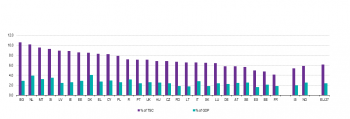
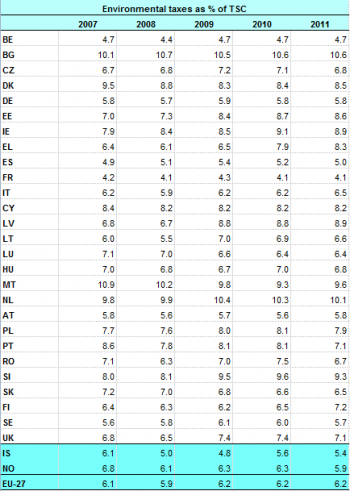

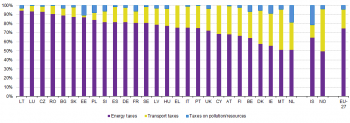



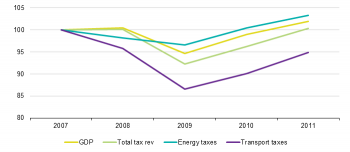
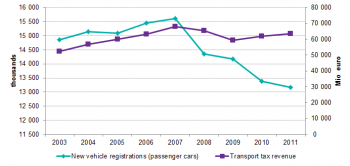


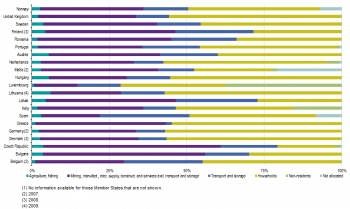
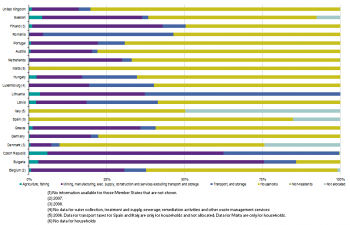

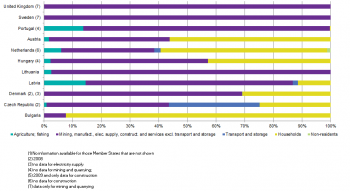

This article provides a detailed analysis of environmental taxes in the European Union (EU), completing the overview article on environmental tax statistics and presenting recent developments in the different types of environmental taxes (energy, transport, pollution and resource taxes) in the EU. The EU-27 raised around EUR 303 billion from environmental taxes in 2011, corresponding to 2.4 % of gross domestic product (GDP) and 6.17 % of revenue from total taxes and social contributions (TSC).
As a percentage of TSC, the trend of environmental taxes has been downward throughout the period 1995 to 2008, with environmental tax revenue dropping by 1 percentage point of TSC to 5.92 % in 2008. A brief rise to 6.23 % occurred in 2009 due to the fall in government revenue which resulted from the financial crisis. In 2010, however, the percentage again decreased to 6.20 % of TSC, reaching 6.17 % in 2011. The many causes for this continued decline in importance of environmental taxes are explained further down in this article.
Main statistical findings
Environmental taxes account for 6.17 % of all revenues from taxes and social contributions in the EU-27 in 2011 with environmental tax revenues amounting to EUR 303 billion.
Energy taxes represent three quarters of EU-27 environmental tax revenue in 2011
An environmental tax is one whose tax base is a physical unit (or a proxy of it) of something that has a proven, specific negative impact on the environment. Environmental taxes can be of four types: energy, transport, pollution and resource taxes. Energy taxes include taxes on energy products (e.g. coal, oil products, natural gas and electricity) used for both stationary purposes and transport purposes.
In 2011 almost 75 % of all environmental taxes were energy taxes. By convention, CO2 taxes are also included in this tax category since they are usually levied on energy products. Including CO2 taxes with pollution taxes rather than energy taxes would distort international comparisons.
Transport taxes mainly include taxes related to the ownership and use of motor vehicles. In 2011, 21 % of EU-27 total environmental tax revenue came from transport taxes.
Pollution and resource taxes cover different types of taxes: taxes on the extraction of raw materials; on measured or estimated emissions to air (e.g. NOx and SO2) and water; on noise and on the management of waste. Only 4 % of EU-27 total environmental tax revenue was raised by pollution and resource taxes in 2011.
Compared with 1995, environmental tax revenue has increased by more than 110 billion EUR, which is an increase of 59 %, but as percentage of GDP (and TSC) it has declined (see Table 1). In comparison to GDP, environmental tax revenue increased during the 1990s reaching a maximum in 1999 of 2.80 % of GDP. Since then, environmental tax revenue as a percentage of GDP has gradually fallen, reaching a historical minimum of 2.32 % in 2008. During the last three years (2009-2011) it has been steady around 2.39 %. The distribution of the tax categories has remained roughly the same.
Environmental tax revenues in European countries in 2011
When comparing the environmental tax revenue to GDP, most of the countries were in a range between 2 % and 3 % of GDP in 2011 (see Figure 2). Denmark and the Netherlands had the highest ratios at 4.1 % and 3.9 % of GDP respectively. Spain, Lithuania, France, Slovakia, Romania and Iceland are the only countries where environmental taxes were less than 2 % of GDP. The EU-27 average was 2.4 % of GDP.
When comparing environmental tax revenue to TSC (see Figure 2) a vast majority of European countries showed levels of environmental tax revenue in a band ranging from 6 % to 10 % of TSC in 2011. Only in Bulgaria and the Netherlands did more than 10 % of TSC came from environmental taxes. In France, Belgium, Spain, Iceland, Sweden, Austria, Germany and Norway less than 6 % of TSC was raised from environmental taxes. The EU-27 average was 6.2 % of TSC.
Tables 2 and 3 show the environmental taxes as a % of GDP and TSC in the last 5 years by country as well as for EU-27. Detailed figures by country are also available in Table 4 at the end of the article.
When comparing the distribution of the different tax types across countries (see Figure 3), large differences can be seen.
Many of the eastern European countries and Luxembourg raise 85 % or more of their environmental tax revenue from energy taxes. This is due to the higher energy intensity of eastern European economies compared with the EU-15, which renders their tax bases larger than those in the EU-15. In Luxembourg the high share for energy taxes is due to the high amount of road fuels sold in the country to non-residents, which increases the tax base for energy taxes compared to the other European countries.
At the other end of the scale, in Malta and Denmark transportation taxes were almost as significant as energy taxes. The Netherlands, Iceland, Estonia, Ireland, Poland, Belgium, Slovenia and France were the only countries in which pollution and resource taxes accounted for more than 5 % of total environmental tax revenue. Detailed figures by country are available in Table 4.
Comparing the evolution of environmental tax revenue in European countries
While environmental taxes as a share of GDP have converged to a level between 2 % and 3 % of GDP in most European countries in the period from 1995 to 2011, the share of environmental tax revenue in % of TSC has not followed the same trend (Figure 4).
Figure 4 shows the development of environmental taxes in relation to TSC throughout the EU-27. Countries are grouped and ordered by the relative ( % of TSC) change between 1995 and 2011. Those with the largest relative increases in environmental tax revenue in % of TSC are in the top left graph of Figure 4. Those with the largest relative decrease in environmental tax revenue in % of TSC are in the bottom right graph of Figure 4.
Many eastern European countries record an increase in environmental tax revenue (in % of TSC) since 1995.
Estonia, Latvia and Bulgaria are the countries with the largest positive change in environmental tax revenue. In particular Estonia moved towards a greener taxation system, increasing the share of environmental taxes in TSC from 2.7 % in 1995 to 8.6 % in 2011, which is the largest increase in the EU-27. This is partly due to the fact that total tax revenues are lower in Estonia than the rest of the EU countries giving environmental taxes a larger share. The positive change in the share of environmental taxes in TSC in Estonia is also related to the increase in revenues from fuel excise duty. Fuel excise duty comprised the majority of the environmental taxes in Estonia and the changes in excise revenues effected the volume of environmental taxes. Even though there have been fluctuations in Lithuania, Germany and Romania, the level in 2011 was about the same as it was in 1995.
On the other hand, Portugal and Iceland observed large decreases in the environmental tax share of TSC since 1995. In Portugal it went down from 11.5 % to 7.1 % and in Iceland from 9.6 % to 5.4 %. The decrease in Portugal might be explained by the high initial level, combined with a lack of indexation of taxes and low company car taxation. These are discussed in the publication “Tax reforms in EU Member States 2012” (EU, 2012).
In 1998, Malta and Slovenia showed notable peaks in the share of environmental taxes in relation to TSC, as did Romania in 1999. This was due mainly to changes in revenues from direct taxes and social security contributions paid by employers. There was also a major change in the tax system in Slovenia in 1999 when VAT replaced the previous sales tax.
The evolution of environmental tax revenue and the financial crisis
The financial crisis had a large impact on GDP and tax revenues in the EU.
EU-27 energy tax revenues in % of GDP dropped by 15% in the period 1995-2011 (Figure 5). Most of this decrease occurred in the period 2003-2008 when GDP grew at a faster pace than energy tax revenue.
There are several possible reasons for the decoupling of the growth rates of energy tax revenue and GDP in the EU-27.
Energy intensity is the ratio between the gross inland consumption of energy and the gross domestic product (GDP) for a given calendar year (see Figure 6). The gross inland consumption of energy is calculated as the sum of the gross inland consumption of five energy types: coal, electricity, oil, natural gas and renewable energy sources. The GDP figures are chain linked volumes with reference year 2005. The energy intensity ratio is determined by dividing the gross inland consumption by the GDP. Energy consumption had been growing more slowly than GDP, which could have been the result of higher energy prices (the oil price tripled between 2003 and 2011) and energy efficiency policies.
The switch towards renewable energy may have eroded the tax base since renewable energies (for example biofuels) are often taxed less or completely exonerated from taxation.
It would have been possible to balance the erosion of the tax base by an increase in energy tax rates. However, governments may have been reluctant to increase tax rates or introduce new taxes on energy products because of the already high price for households and businesses.
At the same time governments have started to put in place mechanisms other than taxes which affected energy demand (e.g. energy saving programmes).
Figure 7 gives a closer look at the development from 2007 to 2011. Values for GDP, total tax revenue, energy taxes and transport taxes are all indexed for comparability. Between 2007 and 2009 GDP dropped by 5.3 % and total tax revenues by almost 8 %. Looking closer at the two larger types of environmental taxes, energy and transport, there are some differences in volatility.
While in 2008 both GDP and total tax revenue were close to their level in 2007, energy tax revenue and transport tax revenue both decreased. The decrease then continued through 2009, but at a slower pace for energy tax revenue than for total tax revenues and GDP. The largest impact seems to have been on transport taxes, where revenue fell by almost 10 % in 2009. In 2011 GDP, total tax revenue and energy tax revenue had all recovered or surpassed the 2007 level, while transport tax revenue was still 5 % lower than in 2007.
Transport taxes are levied mainly on vehicles at the time they are sold (e.g. sales taxes) and then for every year they remain in circulation (e.g. circulation taxes). Thus, the revenue from transport taxes tends to follow the dynamics of the vehicle stock and of vehicle sales. The stock of passenger cars, goods vehicles and buses and coaches has been growing.
However, in 2007-2011 passenger car sales in the EU-27 slowed down due to the economic crisis (see Figure 8). In countries with high car sales taxes, an economic downturn can have a big impact on car sales and therefore on revenues from such taxes.
Furthermore governments may have reduced sales and circulation taxes on vehicles in order to counterbalance the effects of the economic crisis.
These two factors could partly explain the reduction in transport tax revenue after 2007 (see Figure 9).
Implicit tax rate (ITR) on energy
The indicator is defined as the ratio between energy tax revenues and final energy consumption calculated for a calendar year. Energy tax revenues are measured in euro (deflated with the final demand deflator) and the final energy consumption in TOE (tonnes of oil equivalent) therefore the ITR on energy is measured in EUR per TOE.
This is a Sustainable Development Indicator (SDI). It has been chosen for the assessment of the progress towards the objectives and targets of the EU Sustainable Development Strategy.
The ITR on energy for EU-27 increased between 2010 and 2011 from 175.1 to 183.8 (Figure 10). The highest level of ITR in 2011 as well as in 2010 was in Denmark (almost double the ITR for EU-27) and the lowest in Slovakia (almost four times less than the EU-27 level). The real burden of taxation on energy has increased in 2011 from 2010 levels in nearly all EU member States (with the highest increase of 14 % in Malta), except for Portugal, Slovenia, Spain, Belgium, Romania, Hungary, Bulgaria and Lithuania where it decreased.
Who pays energy taxes?
Eurostat collects data on environmental tax revenue (by type - energy, transport, pollution and resource taxes) broken down by economic activities (tax payers). These detailed data become available later than the overall revenue data. Thus the last reference year for which data is available is 2010.
In 2010 most of the revenue governments raised from energy taxes came from households and businesses (in agriculture, mining and manufacturing industry, electricity supply, construction and services) and only small amounts from non-residents (see Figure 11). On average, households paid just under half of the energy tax revenues collected by governments. Exceptions to this are the Czech Republic where households paid around 18 % of energy taxes and Latvia where households paid 27 % of energy taxes. In these countries the business sector paid a larger share than in other countries.
The contribution of agriculture to total energy tax revenues was less than 6 % in all countries for which data are available.
The share of energy taxes in the total revenue from environmental taxes differs widely across the countries – for details see Table 4.
Who pays transport taxes?
The main contributors to transport tax revenue in 2010 were households, paying on average around 68 % of all transport taxes, followed by businesses (agriculture, fishing, mining, manufacturing, electricity supply, construction and services) with around 17 %. The share paid by non-residents was negligible. Households paid the highest share in Spain, UK, Germany and Austria at around 80 %. In many of the European countries, the transport industry paid less than 10 % of transport taxes. The most important exception is Lithuania (see Figure 12), where the transport industry alone paid more than 60 % of transport taxes. The share of transport taxes in the total revenue from environmental taxes is however very low in Lithuania - for details see Table 4.
Who pays pollution taxes?
Around 12 % of all pollution tax revenue in 2010 came from manufacturing alone and households paid around 40 % of all pollution taxes (amongst the countries for which there are data). The share paid by non-residents was negligible. In Romania and Spain the shares of manufacturing alone in pollution taxes were 39 and 33 % respectively of all pollution taxes. Households in the Netherlands paid the highest share of pollution taxes (67 %) followed by households in Norway (53 %). In many of the European countries, the transport industry paid less than 10 % of pollution taxes. The most important exceptions to this are Lithuania and Romania (see Figure 13), where the transport industry alone paid 14 and 20 % respectively of pollution taxes. The share of pollution and resource taxes in the total revenue from environmental taxes is however very low in these two countries - for details see Table 4.
Who pays resource taxes?
The data for resource taxes is very limited. On average among the countries for which data exist, households paid 37 % of the resource tax revenues collected by governments (see Figure 14). Exceptions are Lithuania, Portugal, Sweden and UK where the part of households is very small. In these countries mining and quarrying as well as water supply, sewerage and waste management paid a large part of the resource tax revenues. Mining and quarrying paid around 38 % of total resource taxes on average. The contribution of agriculture to total resource tax revenues was less than 2 %. The share of resource taxes in the total revenue from environmental taxes differs widely across the countries – for details see Table 4.
Data sources and availability
Eurostat using Table 9 from the ESA transmission programme, gathers data on environmental tax revenues for four categories of environmental taxes (energy, transport, pollution and resources). Eurostat collects also data on environmental taxes at a more detailed level, by economic activity. A Eurostat publication titled ‘Environmental taxes - a statistical guide’ constitutes the methodological basis; this annual collection of data by economic activity has been based so far on a Gentlemen’s Agreement.
Data relating to environmental taxes can be used to analyse the revenue stream from such taxes, as well as providing a relative measure of the importance of these taxes through the calculation of ratios relative to GDP or the total revenue from all taxes and social contributions. In the first case, the comparison helps to provide an understanding of the tax burden. In the second case, the comparison helps assess whether or not there is a shift towards environmental taxes, in other words, shifting the tax burden from other taxes (for example, on labour income) towards environmental taxes.
Environmental tax revenue can also be allocated according to the different economic activities paying the taxes. Eurostat collects data on environmental taxes using a breakdown by economic activity (the NACE Rev. 1.1 and NACE Rev. 2 classifications supplemented by information for households, non-residents and a category not allocated).
Increasing revenues from environmental taxes should be interpreted with caution. The increases may be caused by the introduction of new taxes or an increase in tax rates, or alternatively may be linked to an increase in the tax base.
Satellite accounts are a set of accounts that can be used to supplement national accounts; they exist/are in the process of being developed in a range of areas (for example, health accounts, tourism accounts or environmental accounts). An important feature of satellite accounts is that the basic concepts and classifications of the national accounts framework are retained.
Regulation (EU) No 691/2011 on European environmental economic accounts was adopted on 6 July 2011. The Regulation provides a framework for the development of various types of environmental accounts (also referred to as modules). Environmental taxes by economic activity are one of the three modules included in the Regulation (Annex II). The Regulation makes the delivery of data on environmental taxes by economic activities obligatory. Eurostat will release the first data based on the Regulation at the beginning of 2014. This Regulation will provide a substantial increase in data availability on environmental taxes by economic activity and allow for more analysis of the data.
Context
Economic instruments for pollution control and natural resource management are an increasingly important part of environmental policy in the EU Member States. The range of instruments that are available includes, among others, environmental taxes, fees and charges, tradable permits, deposit-refund systems and subsidies.
Environmental taxes have been increasingly used to influence the behaviour of economic operators, whether producers or consumers. The EU has increasingly favoured these instruments because they provide a flexible and cost-effective means for reinforcing the polluter-pays principle and for reaching environmental policy objectives. The use of economic tools for the benefit of the environment is promoted in the Proposal for a new EU Environment Action Programme to 2020 - 7th environment action programme (EAP), the renewed EU sustainable development strategy and the Europe 2020 strategy.
See also
Further Eurostat information
Publications
- Environmental taxes account for 6.2 % of all revenues from taxes and social contributions in the EU-27 - Statistics in focus 53/2012
- In 2009, EU-27 environmental tax revenue rose to 2.4 % of GDP - Statistics in focus 67/2011
- Taxation trends in the European Union - Data for the EU Member States, Iceland and Norway, 2013
- Tax revenue in the European Union, 2012
- Europe in figures- Eurostat yearbook 2012
- Energy, transport and environment indicators - Pocketbook, 2012
- Key figures on Europe - 2012 edition - Pocketbook, 2012
- Environmental statistics and accounts in Europe - Statistical books, 2010
Main tables
- Environmental taxes, see:
- Total environmental tax revenues as a share of total revenues from taxes and social contributions
- Total environmental tax revenues as a share of GDP]
Database
- Environmental taxes, see:
Dedicated section
Methodology / Metadata
- Environmental taxes by economic activity (ESMS metadata file — env_ac_taxind_esms)
- Environmental tax revenues (ESMS metadata file — env_ac_tax_esms)
- Implicit tax rate on energy (ITR) (ESMS metadata file — tsdcc360_esmsip)
Source data for tables and figures (MS Excel)
![]() Environmental taxes: tables and figures
Environmental taxes: tables and figures
Other information
- European Environment Agency (EAA)
- Environmental tax reform in Europe: implications for income distribution, EEA Technical report No. 16/2011, Copenhagen
- Market-based instruments for environmental policy in Europe, Copenhagen, 2005
- Environmental taxes - Recent developments in tools for integration, Copenhagen, 2000
- Environmental Taxes - Implementation and Environmental Effectiveness, Copenhagen, 1996
- Regulation 691/2011 of 6 July 2011 on European environmental economic accounts
External links
- European Commission